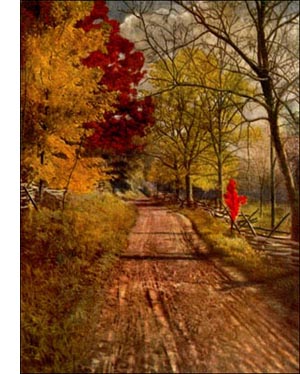Pecan Hickory Tree
 Pecan (Hicoria Pecan, Britt.)-Large, thick-trunked tree with broad top; 100 to 170 feet high, 4 to 6 feet in diameter at base. Bark light reddish brown, broken into small, scaly plates; branches smooth, twigs pubescent, with orange-coloured lenticels. Hood light brown, compact, heavy, hard, not strong. Buds small, yellow, pointed, pubescent, with narrow scales that elongate slightly in spring. Leaves 12 to 20 inches long, of 9 to 17 leaflets, short petioled, often falcate, lanceolate, serrate, bright yellow-green above, paler below; petioles yellow. Flowers: staminate in catkins, profuse; pistillate terminal, in spikes; each flower greenish, scurfy, q-angled, tapering. Fruit 3 to 11 in cluster, pointed at both ends, elongated, husk thin, 4-angled, winged at sutures which open at maturity; nut smooth, reddish, cylindrical, thin shelled; kernel sweet, with red, astringent, granular coat. Preferred habitat, low, rich ground near streams. Distribution, southern Iowa, Illinois and Indiana, and Southern States bordering the Mississippi River to central Alabama. Range extended by cultivation into all Southern States. Uses: Most valuable native nut tree. Wood not much used in construction; excellent for fuel. Fine shade and ornamental tree.
Pecan (Hicoria Pecan, Britt.)-Large, thick-trunked tree with broad top; 100 to 170 feet high, 4 to 6 feet in diameter at base. Bark light reddish brown, broken into small, scaly plates; branches smooth, twigs pubescent, with orange-coloured lenticels. Hood light brown, compact, heavy, hard, not strong. Buds small, yellow, pointed, pubescent, with narrow scales that elongate slightly in spring. Leaves 12 to 20 inches long, of 9 to 17 leaflets, short petioled, often falcate, lanceolate, serrate, bright yellow-green above, paler below; petioles yellow. Flowers: staminate in catkins, profuse; pistillate terminal, in spikes; each flower greenish, scurfy, q-angled, tapering. Fruit 3 to 11 in cluster, pointed at both ends, elongated, husk thin, 4-angled, winged at sutures which open at maturity; nut smooth, reddish, cylindrical, thin shelled; kernel sweet, with red, astringent, granular coat. Preferred habitat, low, rich ground near streams. Distribution, southern Iowa, Illinois and Indiana, and Southern States bordering the Mississippi River to central Alabama. Range extended by cultivation into all Southern States. Uses: Most valuable native nut tree. Wood not much used in construction; excellent for fuel. Fine shade and ornamental tree.One of the things that solaced Evangeline's people, homesick for their lost Acadia, and wandering in a new and unknown region, was the wealth of sweet, nutritious nuts that grew on trees the Indians called pecans. The "Cajons" called the trees, Pecanier, translating the name into their own language. Twice it stood between them and famine before they became established along the lower courses of the Great River.
The salvation of the pecan tree is the inferiority of its wood. Being brittle, it does not commend itself to the makers of wagon tongues and axe handles. Many a superb specimen adorns the roadside and more than pays its way at nut harvest, while other hickories have all been felled and dragged off to the factory. No finer tree adorns the avenues of Southern cities than the pecan. Furthermore, the value and importance of the nut crop is an everincreasing quantity.
Orchards of pecans are being planted, large thin-shelled nuts being chosen for seed. Grafting and budding have been attempted, but usually failed. Success in this is coming and will quickly improve the character of the nuts, only the trees with the best nuts being used for propagation by enterprising growers. Good seed cannot be depended upon to reproduce itself in the fruit of the seedling trees. Cions and buds produce the same sort of nuts, when they come to bear, as the parent tree.
Pecans are, 95 per cent. of them, still gathered in the woods. Buyers pay nut gatherers from 3 cents to 5 cents per pound for them at the railroad. The retailer gets 15 cents to 75 cents per pound. The yield varies with the years, and quantities are kept over in cold storage against a nut famine. The prices fluctuate surprisingly, and offer great opportunities for speculation.
The shiny red pecans in the grocer's box owe their polish and fresh colour to rapid friction with other nuts in revolving barrels. Unfortunately this process restores the bloom of youth to the shells of stale nuts which are commonly mingled with the fresh ones. In many places the nuts are cracked and shelled, the meats sold at 50 cents to 6o cents per pound. There is economy of time, at least, in this for the confectioner and the cook.
The "get-rich-quick" man is sure to be interested in pecans and pecan culture. Large, thin-shelled nuts, for seed, bring from 50 cents to $2.50 per pound. Budded and grafted trees, one or two years old, cost from 50 cents to $1.50 each at the nursery. An orchard of thrifty, prolific trees, whose nuts have thin-shelled, plump kernels, with delicate flavour and the minimum of the astringent red shell lining, is certainly as good as a gold mine on any farm.
Of the seventy and more varieties that have been described, not twenty are worth considering. Anyone interested in the subject should get the Report on Nut Culture, Division of Pomology, Department of Agriculture, Washington, D. C.